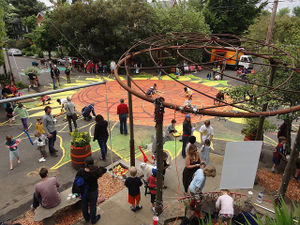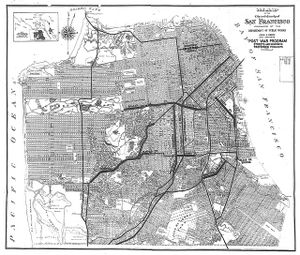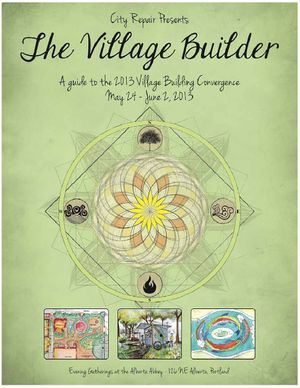
City Repair Project[edit | edit source]
City Repair Project (CRP) is a non-profit organization 501(c)3 that began in 2001 in Portland, OR. To CRP, "localization of culture, economy, and decision-making" is crucial feature of sustainable communities. CRP encourages and empowers individuals of communities to reclaim public space through artistic and ecologically-responsible projects that tear down the barriers between humans and the natural environment [1]. By empowering people to transform their public spaces, CRP and the people they work with have challenged norms and created active and engaged communities.
The Grid System[edit | edit source]
CRP makes efforts to reestablish the civil aspect of civilization, especially in regards to the modern urban grid standard. Although not the first to utilize the grid system, the Romans largely introduced the urban grid as an effective city planning system [2].

In the grid system, travelers could meet with other travelers at regular intervals, where the streets intersected. But as people began to drive cars more often, intimate interactions began to dwindle. Intersections have become places where traffic and tensions builds up, people don't signal, and violence has increased. CRP believes that the grid system has lead to people feeling isolated from their communities, and has thereby made it difficult for community space to flourish. Whereas cities and towns without a grid system have naturally occurring space for gatherings, with the grid system, meeting places need to be deliberately planned [3].
Placemaking[edit | edit source]
Architects and city planners have been conceptualizing human reclamation of streets since the 1960s.

Jane Jacobs and William H. Whyte were among the first pioneers of city planing that was centered on people's needs and aspirations, not cars and supermarkets. This idea is called Placemaking, and its visionaries believe that "when you focus on place, you do everything differently" [4]. By opening neighborhood planning to local residents, the focus shifts from managing people as they shuffle between A and B, to empowering residents to shape their own community experience.
Projects[edit | edit source]

CRP works on many projects around Portland, including the annual Village Building Convergence, a "placemaking festival" that blends activism, hands-on education, community development, and art to create partnerships between governments, residents, and communities [5]. The Village Building Convergence lasts ten days and the event in 2013 will begin May 24th [6]
CRP is also involved in various intersection repair, natural building, and placemaking projects around Portland [7].
Sunnyside Piazza[edit | edit source]

The Sunnyside Piazza is perhaps one of CRP's most famous intersection repair projects. This inner-city intersection in Portland, OR. was transformed into a community space in 2001, in efforts to reduce neighborhood crime and increase individual sense of place [8]. The project seems to have had a positive effect; a study by Jan C. Semenza showed that people in the Sunnyside neighborhood were 30% happier with their neighborhood than people in a nearby neighborhood with a similar demographic [9].
Placemaking in Arcata[edit | edit source]
The Creamery District in Arcata, CA is also jumping on the placemaking bandwagon. In May 2013, Playhouse Arts granted five local artists a total of over $7,000 to work on art projects in communal spaces in the Creamery District.

Installations:
- Maila Penhall: knitted socks, pom-poms, etc. in a tree cluster
- Susan Bloch: mixed-media rainbow-making mobile named the Zephyr
- Tim Gray: digital music sounds to accompany a walk-through visit of the District
- Robert Pabst: street mural at the intersection of 9th and L streets
- Lori Goodman: sculpture of paper, wood, and bamboo paying homage to the kozo plant
[10].
The projects were completed in August of the same year, and are viewable by taking a walk around 8th and 9th streets on the east side of K Street.
Mark Lakeman[edit | edit source]
Mark Lakeman is an urban place-maker and a co-founder of CRP. As an urban permaculturist, community designer, and activist, Lakeman has worked on many projects with many organizations, including:
- Communitecture Inc.
- the Planet Repair Institute
- Creative Vision
- the Last Thursday Arts & Culture Project
- the Intersection Repair Project
- the T-Horse mobile public gathering place
- Dignity Village
- CRP and VBC.
Lakeman worked as a large-scale project designer in the 1980s, until starting other urban projects that mimicked indigenous and marginalized societies in terms of community participation, and localized ownership of political and economic power. [11].
Lakeman finished his 2013 California tour on November 11, after speaking at the California Student Sustainability Coalition Convergence at Cal Poly Humboldt. See his calendar for his planned 2014 stops, including various towns on the East Coast of the US; Santa Cruz, CA; Maui, HI; and Breitenbush Resort, OR [12].
External Links[edit | edit source]
- City Repair
- Roman City Planning
- History of the Grid
- Intersection Repair
- Village Building Convergence
- Sunnyside Piazaa Blogspot
- PPS.org
- Jan C. Semenza
- Creamery District
- Communitecture
- Planet Repair
- Creative Visions
- CSSC (Sustainability Coalition)
- HSU Homepage
- T-Horse
- Dignity Village
- Breitenbush Resort
- Mark Lakeman Personal Blog
- Mark Lakeman
- Urban Planning, Art, and Public Health
- Creamery District Funds Art Projects